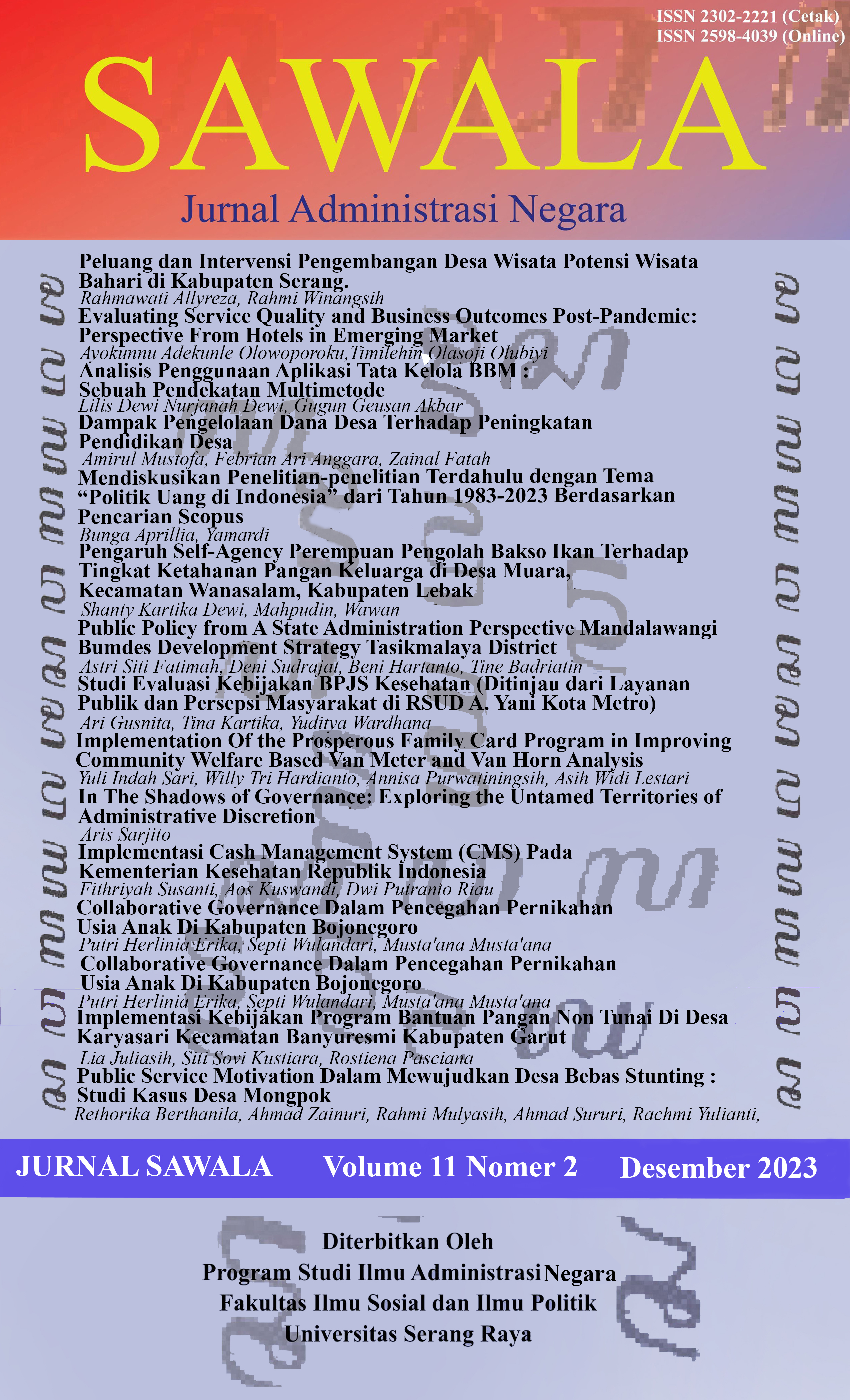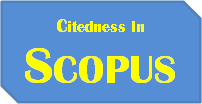Analisis Penggunaan Aplikasi Tata Kelola BBM : Sebuah Pendekatan Multimetode
DOI:
https://doi.org/10.30656/sawala.v11i2.7487Keywords:
Application My PertaminaAbstract
This study aims to analyze the use of the My Pertamina application using a combined method between TAM (Theory Acceptance Model) and TRA (Theory of Reasoned Action). My Pertamina application is a mobile application developed by Pertamina which is used to provide non-cash fuel oil payment services. The TAM and TRA methods are used as the theoretical framework in this study to understand the factors that influence the acceptance and use of the My Pertamina application by users. TAM acceptance theory focuses on factors that influence users' attitudes toward technology adoption, while TRA addresses factors that influence users' intention to use a system.
This research uses a quantitative approach by surveying users of the My Pertamina application. The data collected included users' perceptions of perceived usefulness, perceived ease of use, benefits obtained, perceived subjective norms, and attitudes toward using the application. Data analysis was conducted using regression techniques to test the relationship between the variables in the TAM and TRA models.
References
Al-Qaysi, N., Mohamad-Nordin, N., & Al-Emran, M. (2020). Factors Affecting the Adoption of Social Media in Higher Education: A Systematic Review of the Technology Acceptance Model. In Recent Advances in Intelligent Systems and Smart Applications.
Choi, G., & Chung, H. (2013). Applying the Technology Acceptance Model to Social Networking Sites (SNS): Impact of Subjective Norm and Social Capital on the Acceptance of SNS. International Journal of Human–Computer Interaction, 10, 619–628. https://doi.org/https://doi.org/10.1080/ 10447318.2012.756333
CNN Indonesia. (2022). Tes Aplikasi MyPertamina, Sudahkah Lebih Baik. CNN Indonesia. https://www.cnnindonesia.com/teknologi/20220708201621-185-819268/tes-aplikasi-mypertamina-sudahkah-lebih-baik (diakses pada tanggal 15 Agustus 2023
Davis, F. D., Bagozzi, R. P., & Warshaw, P. R. (1989). User Acceptance of Computer Technology: A Comparison of Two Theoretical Models. Management Science, 35(8), 982–1003. https://doi.org/10.1287/mnsc.35.8.982
Eneh, O. C. (2010). Technology transfer, adoption and integration: A review. In Journal of Applied Sciences (Vol. 10, Nomor 16, hal. 1814–1819). https://doi.org/10.3923/jas.2010.1814.1819
Faqih, M. (2019). The Influence Of Perceived Usefulness, Social Influence, Internet Self-Efficacy And Compatibility On Users’ Intentions To Adopt E-Learning: Investigating The Moderating Effects Of Culture. IJAEDU- International E-Journal of Advances in Education, 5(15), 300–320.
Fishbein, M., & Ajzen, I. (1975). Belief, Attitude, Intention, and Behavior: An Introduction to Theory and Research, Reading. MA: Addison-Wesley.
Gitasela, Y. R., Yanto, & Narti, S. (2023). Analisis Resepsi Khalayak Tentang Aplikasi MyPertamina (Studi Pada Masyarakat Kota Bengkulu). Jurnal Multi Disiplin Dehasen (Mude), 2(2), 405–418.
Goodhue, D., & Thompson, R. L. (1995). Task-Technology Fit and Individual Performance. MIS Quarterly, 19, 213-236. https://doi.org/http://dx.doi.org/10.2307/249689
Hair, J., Black, W., Babin, B., & Anderson, R. (2010). Analisis Data Multivariat. Edisi ke-7. Pearson, New York.
Haryani, D., A, M. S., & Pujani, V. (2014). E-Travel Use in Padang: The Role of Enjoyment, Perceived Ease of Use, and Perceived Usefulness. International Conference on Business, Management & Corporate Social Responsibility (ICBMCSR’14), 25612. https://doi.org/10.15242/icehm. ed0214037
Haryono, S. (2016). Metode SEM Untuk Penelitian Manajemen dengan AMOS LISREL PLS. In Journal of Physics A: Mathematical and Theoretical. http://repository.umy.ac.id/ bitstream/handle/123456789/12640/e bookk_3in1.pdf?sequence=11&isAllowed=y
Henseler, J., Hubona, G., & Ray, P. A. (2016). Using PLS path modeling in new technology research: Updated guidelines. Industrial Management and Data Systems, 116(1), 2–20. https://doi.org/10.1108/IMDS-09-2015-0382
Kaewratsameekul, W. (2018). An Examination of Behavioral Intention to Use Contactless Mobile Payment: Rapid Transit System in Thailand. Science, Engineering and Health Studies, 12(2), 85–101. https://doi.org/10.14456/sehs.2018.2.
Kusnandar, V. B. (2022). Ini Negara dengan Penduduk Terbanyak di Dunia, Indonesia Urutan Berapa? databoks. https://databoks.katadata.co.id/datapublish/2022/09/21/ini-negara-dengan-penduduk-terbanyak-di-dunia-indonesia-urutan-berapa (diakses tanggal 14 Januari 2023)
Lai, M., & Chen, Y. (2012). Self-Efficacy, Effort, Job Performance, Job Satisfaction. International Journal of Innovation, Management and Technology, 3(4), 387–391.
Liu, Y., Jerry Chih-Yuan Sun, & Chen, S.-K. (2021). Comparing technology acceptance of AR-based and 3D map-based mobile library applications: a multigroup SEM analysis. Interactive Learning Environments, 31(2), 1–15. https://doi.org/10.1080/10494820.2021.1955271
Madden, T. J., Ellen, P. S., & Ajzen, I. (1992). A Comparison of the Theory of Planned Behavior and the Theory of Reasoned Action. Personality and Social Psychology Bulletin, 18(1). https://doi.org/https://doi.org/10.1177/0146167292181001
Matti Haveria, McLaughin, C., & Haverilla, K. (2022). The impact of social influence on perceived usefulness and behavioral intentions in the usage of non-pharmaceutical interventions (NPIs). International Journal of Healthcare, 16(1), 1–12.
Moore, G. C., & Benbasat, I. (1991). Development of an Instrument to Measure the Perceptions of Adopting an Information Technology Innovation. Information Systems Research, 2(3), 192–222. https://doi.org/10.1287/isre.2.3.192
Mustamu, D. D., & Putri, Y. R. (2019). Pengaruh Promosi Melalui Aplikasi Mypertamina Terhadap Keputusan Pembelian Bahan Bakar Pertamax Di Masyarakat Kota Bandung. e-Proceeding of Management, 6(2), 5187–5196.
Narimawati, U. (2008). Metodologi penelitian kualitatif dan kuantitatif, teori dan aplikasi. Agung Media.
Norfolk, L., & O’Regan, M. (2020). Biometric technologies at music festivals: An extended technology acceptance model. Journal of Convention and Event Tourism, 22(1), 36–60. https://doi.org/10.1080/15470148.2020.1811184
Puspitasari, A., Widayanto, & Nugraha, H. S. (2023). The impact of perceived ease of use and perceived usefulness on actual system use through intention to use as an intervening variable in subscription video on demand services (Study on Netflix users in Semarang City). World Journal of Advanced Research and Reviews, 18(03), 1354–1366. https://doi.org/10.30574/wjarr.2023.18.3.1230
Rogers, E. M. (1993). Diffusion of Innovations. London: The Free Press.
Roro, R., & Chairina, L. (2021). The Effect of Perceived Usefulness and Perceived Ease of Use on Perceived Value and Actual Usage of Technology on the Online Service of Pt. Garuda Indonesia Tbk. Quest Journals Journal of Research in Business and Management, 9(4), 2347–3002. www.questjournals.org
Sadya, S. (2022). Jumlah Kendaraan Di Indonesia Capai 141,99 Juta Unit Pada 2021. dataIndonesia. https://dataindonesia.id/otomotif-transportasi/detail/jumlah-kendaraan-di-indonesia-capai-14199-juta-unit-pada-2021 (diakses pada tanggal 14 Januari 2023)
Shih, Y. and Fang, K. (2004). The Use of a Decomposed Theory of Planned Behavior to Study Internet Banking in Taiwan. Internet Research, 14, 213–223.
Suharto. (2023). Kebijakan Program Subsidi BBM. Penerbit Widina Bhakti Persada.
Taylor, S and Todd, P. A. (1995). Understanding Information Technology Usage: A Test of Competing Models. Information Systems Research.
Tira, A. C. D. H., Wardana, I. M., & Setiawan, P. Y. (2016). Aplikasi Model Tam Pada Penggunaan E-Newspaper Di Kota Denpasar. E-Jurnal Ekonomi dan Bisnis Universitas Udayana 5.6, 6, 1485–1512.
Trihutama, R. P. (2020). Pengaruh Perceived Ease of Use , Perceived Usefulness, dan Trust Terhadap Behavioral Intention to USE (Studi Pada Pengguna Go-Pay Layanan Go-Jek). Jurnal Kajian Manajemen dan Wirausaha, 2(2), 1–15.
Tsai, W.-C. (2012). A study of consumer behavioral intention to use e-books: the Technology Acceptance Model perspective. Innovative marketing, 8.
Venkatesh, V., & Bala, H. (2008). Technology Acceptance model 3 and a Research Agenda on Interventions. Decision Sciences, 39(2), 273–315. https://doi.org/10.1111/j.1540-5915.2008.00192.x
Venkatesh, V., & Davis, F. D. (2000). Theoretical Extension of the Technology Acceptance Model: Four Longitudinal Field Studies. Management Science, 46(2), 186–204. https://doi.org/10.1287/ mnsc.46.2.186.11926
Venkatesh, V., Thong, J. Y. L., & Xu, X. (2012). Consumer Acceptance and Use of Information Technology: Extending the Unified Theory of Acceptance and Use of Technology. MIS Quarterly, 36(1), 157–178.
Wibowo, A. (2012). Kajian tentang Perilaku Pengguna Sistem Informasi dengan Pendekatan Technology Acceptance Model (TAM). Proceeding Book of Konferensi Nasional Sistem Informasi, April 2008, 1–8.
Yen, K., Chen, J. V., & Cen, D. Y. (2011). Dimensions of self-efficacy in the study of smart phone acceptance. Computer Standards & Interfaces, 33(4).









